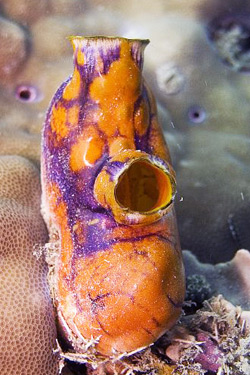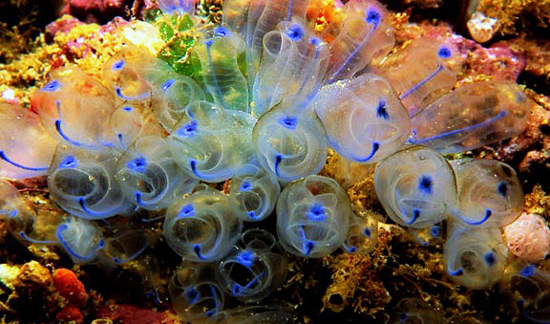Among the more fascinating creatures that commonly make their way into marine aquariums as stowaways on good-quality live rock are tunicates, or sea squirts. In terms of visual interest, these animals can be quite dazzling, with some exhibiting spectacular coloration or resembling small, delicate, translucent pitchers or urns.
What are they?
Tunicates are filter-feeding marine organisms with a very simple body plan. Essentially, they’re water-filled sacks with two openings—an incurrent (or oral) siphon and an excurrent (or atrial) siphon. As you’ve probably deduced already, sea water is drawn into the animal through the incurrent siphon, tiny planktonic particles are filtered out, and then the water is expelled through the excurrent siphon. These creatures can be either solitary or colonial and are often mistaken for sponges. While the tunicates of interest to marine aquarium hobbyists are sessile (attached to hard substrates), there are also pelagic forms, e.g. the salps, floating freely in the ocean.
The name “tunicate” is derived from the tough covering, or tunic (also called a “test”), that many species of these animals exhibit. The term “sea squirt” comes from their ability to forcefully discharge water through their excurrent siphon.
Distant relatives
From a taxonomic standpoint, tunicates are particularly interesting because they aren’t as far removed from humans as they might appear. They actually belong to the subphylum Urochordata (according to ITIS.gov – World Register of Marine Species puts them in the subphylum Tunicata), which falls under the phylum Chordata—the phylum to which we and all other vertebrates belong.
How can an animal with such a simple body plan be considered a chordate? Obviously, they don’t have a backbone, right? That’s true enough, but in the free-swimming larval stage, these animals (looking rather like tiny tadpoles) possess a notochord, or very simple spinal cord, which disappears when the larvae settle and transform into sessile adults.
Tunicates in marine tanks
Unfortunately, while tunicates are really neat to observe, they don’t usually last very long in closed aquarium systems. Because they sustain themselves by filter-feeding on microscopic plankton (of a particle size that’s by no means practical for the average hobbyist to provide), most specimens are doomed to starve to death in captivity. Some may hold on for several months to a year or so, but the end result is more or less preordained.
So, if you end up with hitchhiking tunicates in your tank, enjoy their rare beauty while you can but don’t expect them to be permanent fixtures.





